“Objections to the drawings are usually easy to overcome, but they still must be overcome by submitting replacement sheets. This decreases the efficiency of your operation and increases client costs.”
In Part I of this article, we examined the top three rejections for design patent applications, which are due to non-enablement, inconsistency, and ambiguousness. The fourth most common reason for rejection of design patents is for objections to the drawing disclosure, which we will discuss here.
Objections to the Drawing Disclosure
Objections to the drawings occur when something is incorrectly shown in the drawings, but the drawings are still understood by the Examiner. In the stereo receiver example above, if the bottom plan view was present in the original disclosure but the front elevational view did not show shading on the feet, the Examiner would likely issue an objection, stating that shading was not shown on the front surface of the feet and should be. (If the bottom plan view was not part of the originally filed drawings, then the Examiner would be issuing a Sec. 112 rejection instead of merely an objection since there’s not enough information to understand the shape of the feet and the feet will have to be disclaimed by converting them to broken lines.)
Objections to the drawings are usually easy to overcome, but they still must be overcome by submitting replacement sheets. This decreases the efficiency of your operation and increases client costs, so objections are important to minimize by carefully reviewing your drawings before submission.
Most drawing objections are caused by something not being shaded correctly. For example, round surfaces are shaded as a flat surface, or vice versa, or transparent shading is shown as opaque, etc. Another common objection has to do with the number of elements shown in one figure vs. that shown in another. In this recently-issued design patent, we counted every rib in the top view and in the front view to ensure that the number of external ribs matched the number of internal ribs.

This drain strainer has 72 ribs on the outside, and 49 ribs on the inside, requiring consistency between views.
This can get “hairy,” so to speak, if disclosing hairbrush bristles or something that has a large arbitrary number.
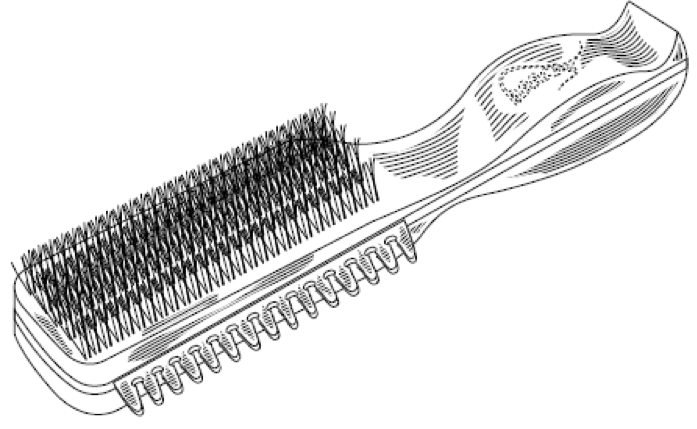
Brush bristles or other elements in large arbitrary numbers need to be consistently illustrated between view
See if you can determine what is shaded incorrectly given the following disclosure for a cable organizing container:

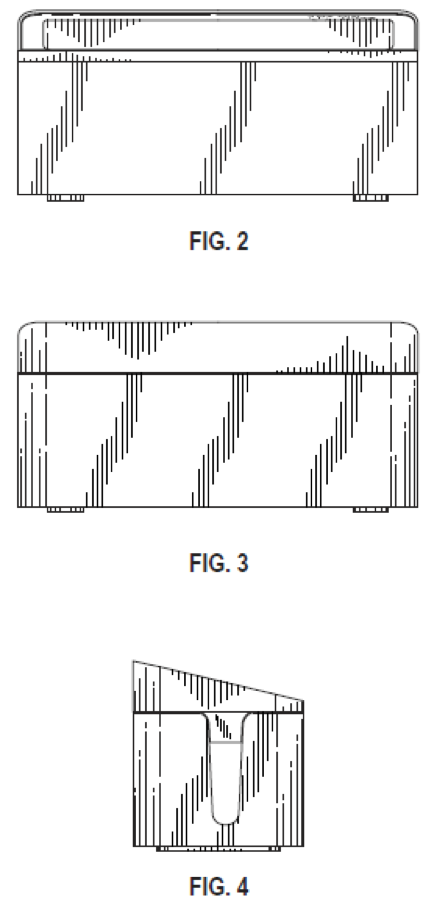
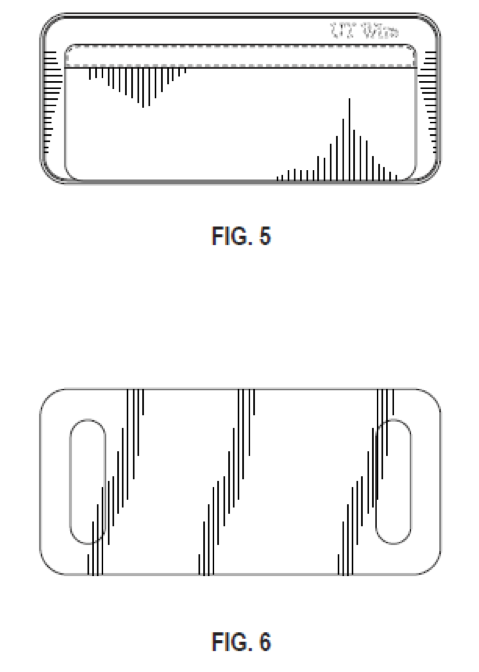
If you need a hint, look carefully at how FIG. 1 compares with FIG. 2, and how FIG. 6 compares with FIGS. 2-4. In FIG. 2 the entire front surface appears flat from left-to-right, whereas in FIG. 1 the corners are curved. And in FIG. 6 the feet appear to be in the same plane as the bottom of the container due to the shade lines crossing the feet boundary. Both of these are incorrectly shaded, but since there is support for their true shape in the rest of the disclosure, we can just make the correction on replacement sheets and file those at the PTO.
Here are the corrected FIGS. 2 and 6:
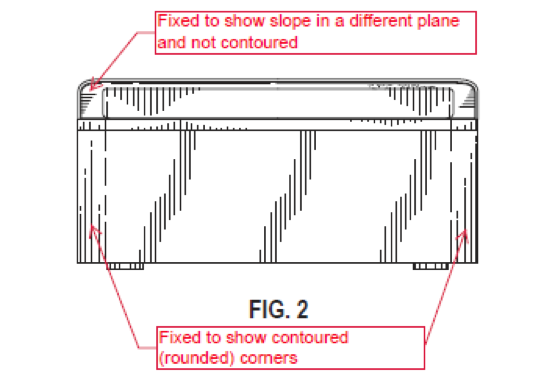
Corrected FIG. 2 with annotations
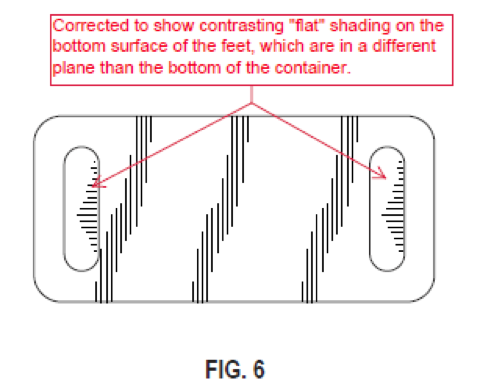
Corrected FIG. 6 with annotations
Alignment sheets won’t usually help you with objectionable shading, so you just have to spend the time reviewing each surface in each drawing, comparing it to the other drawing figures to see if it makes sense. A surface that is not shaded is an immediate red flag. (Interestingly, you’ll have to remove all of the shading in your design patent drawings if a client wants to file the same application in China and many other foreign jurisdictions, as many countries not allow surface shading for design patents.)
Finally, objections are frequent when the position of drawing elements change. The location of a zipper pull in the front view may be shown in a different position in the side view, for example.
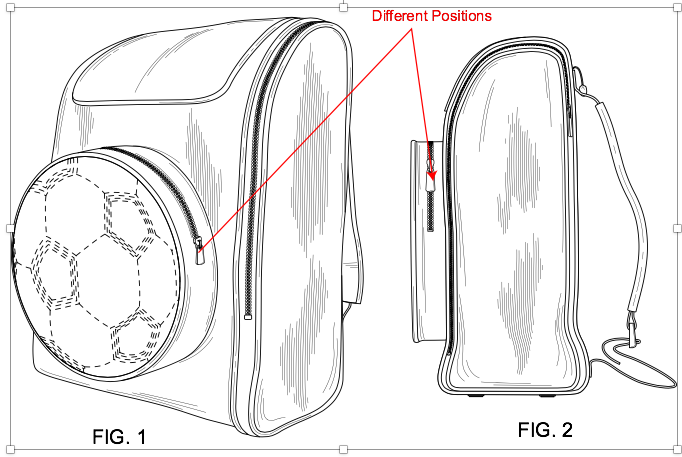
Draftspersons are notorious for missing such small details, and frankly, so are patent practitioners. We often rely on photos taken by the clients and don’t look carefully at the small details like zipper positions, which could easily change if the client is taking the photos. Clients, draftspersons, and practitioners do not often appreciate that changing the position of a zipper, or the rotational position of a wheel (as evidenced by the location of the inflation nozzle), or the degree to which a door or drawer in a cabinet is open, are all aspects that the design patent Examiner looks for and finds. Examiners have an amazing, and sometimes confounding, attention to detail.
Skilled Help Will Get You From A to Allowed
The tips outlined in these two articles should help you prevent Section 112 rejections and drawing objections, but it’s important for your draftsperson to be well-versed in design patent drawings, and to welcome the requirement of producing an alignment sheet. It’s also very helpful to have a colleague or other practitioner who understands design practice to review the drawings before submitting them. When these steps are followed, you should go from APP.FIL.RCP (application filed) to NOA (patent allowed) without any troubling detours in between.

![[IPWatchdog Logo]](https://ipwatchdog.com/wp-content/themes/IPWatchdog%20-%202023/assets/images/temp/logo-small@2x.png)

![[Advertisement]](https://ipwatchdog.com/wp-content/uploads/2024/04/UnitedLex-May-2-2024-sidebar-700x500-1.jpg)
![[Advertisement]](https://ipwatchdog.com/wp-content/uploads/2024/04/Artificial-Intelligence-2024-REPLAY-sidebar-700x500-corrected.jpg)
![[Advertisement]](https://ipwatchdog.com/wp-content/uploads/2024/04/Patent-Litigation-Masters-2024-sidebar-700x500-1.jpg)

![[Advertisement]](https://ipwatchdog.com/wp-content/uploads/2021/12/WEBINAR-336-x-280-px.png)
![[Advertisement]](https://ipwatchdog.com/wp-content/uploads/2021/12/2021-Patent-Practice-on-Demand-recorded-Feb-2021-336-x-280.jpg)
![[Advertisement]](https://ipwatchdog.com/wp-content/uploads/2021/12/Ad-4-The-Invent-Patent-System™.png)






Join the Discussion
6 comments so far.
Jim Gandy
November 26, 2019 03:38 pmAs a retired design patent examiner, supervisor and practice specialist I find your two articles to be an excellent road map for practitioners and designers to avoid the pitfalls of filing a design patent application with insufficient and inadequate drawings. I have a patent agent that does not file design patent applications without my reviewing the drawings for sufficiency of disclosure, clarity, consistency and enablement. It cannot be over emphasized that the drawings in a design patent application are the most critical part of the application as they are the claim and enabling disclosure for purposes of satisfying the requirements of 35 U.S.C. 112. Well done Kevin.
Kevin Prince
November 24, 2019 07:19 pm@Jerome
>” I have a lot of designs that’s on typin paper and my designs is in black and white with the stich work you know back bottom side etc”
Are you sketching these by hand? If so that’s potentially a problem. A CAD file is best because then you’ll have automatic agreement (see @Charles L Mauro above). But sketches can introduce all sorts of inconsistencies, and they’re more difficult to update if you have to amend the drawings a year or so later. I’d stick with a CAD system or at the very least a 2D drawing program like Adobe Illustrator, just so it’s easier to update later if needed.
Charles L Mauro
November 24, 2019 03:22 pmKevin: Excellent Part 2: One of the methods that my team utilizes is to always generate a SolidWorks CAD file of the ornamental design and save the file in orthographic projection compatible with the MPEP. Then give that file to the draftsperson to use in Adobe Illustrator. If you create an ornamental design in a robust CAD program first there is no way to not have the details correct between views. The very structure of how CAD works guarantees you will have correspondence between views. Even though this costs a bit more it saves time and huge problems during litigation.
jerome fields
November 22, 2019 04:47 pmhey kevin I design footwear I have a lot of designs that’s on typin paper and my designs is in black and white with the stich work you know back bottom side etc when I send my design app do you think i’ll be successful cause companies won’t deal with you without a patent pending or.
TFCFM
November 22, 2019 10:28 amHear, hear.
I haven’t worked much with design patents, and appreciate better appreciating how much I don’t know and would have likely overlooked.
Many thanks.
Pro Say
November 21, 2019 03:06 pmExcellent information Kevin — I’m sure I speak for at least some 100’s of Gene’s many readers in giving you a big thanks.